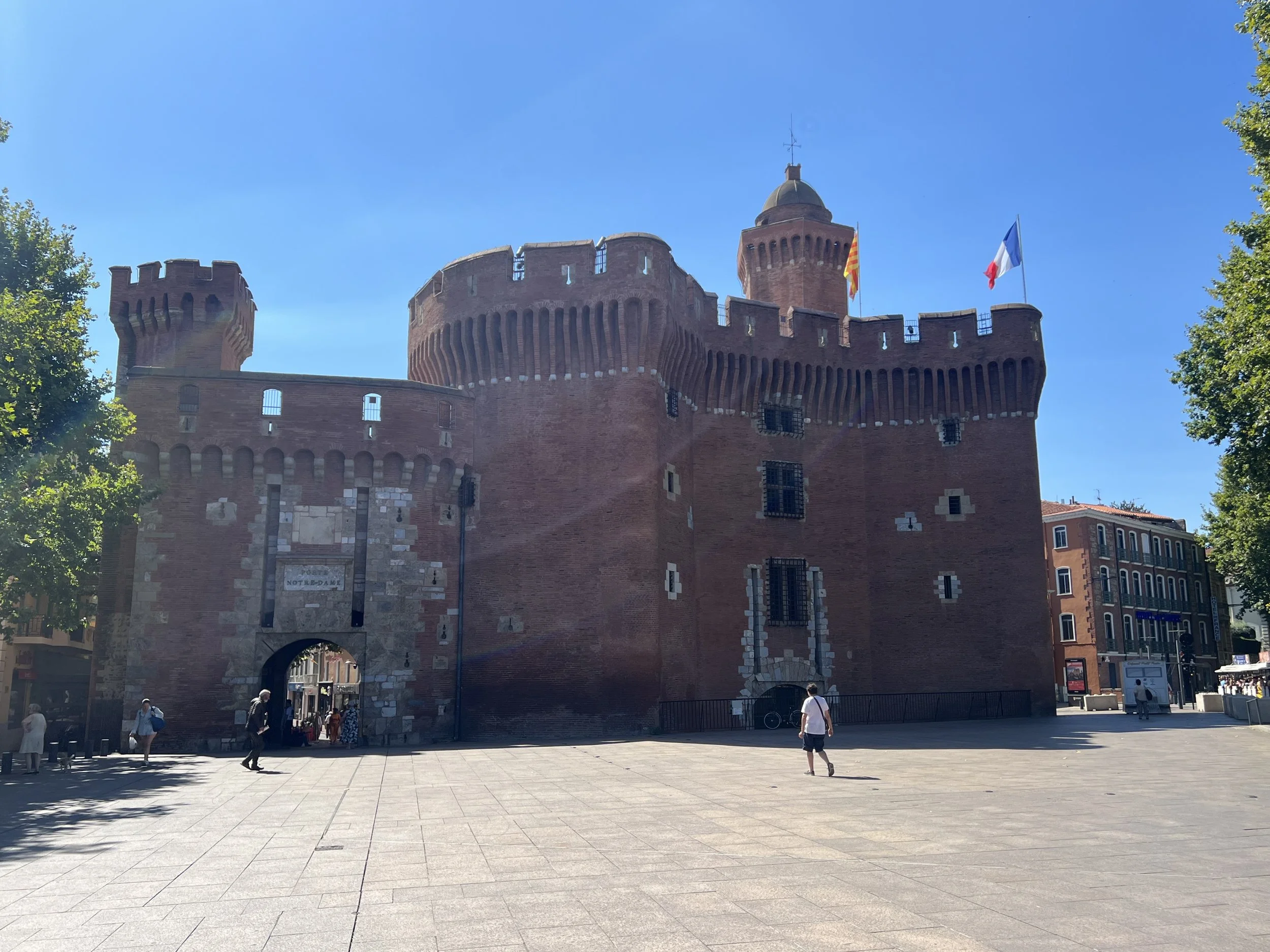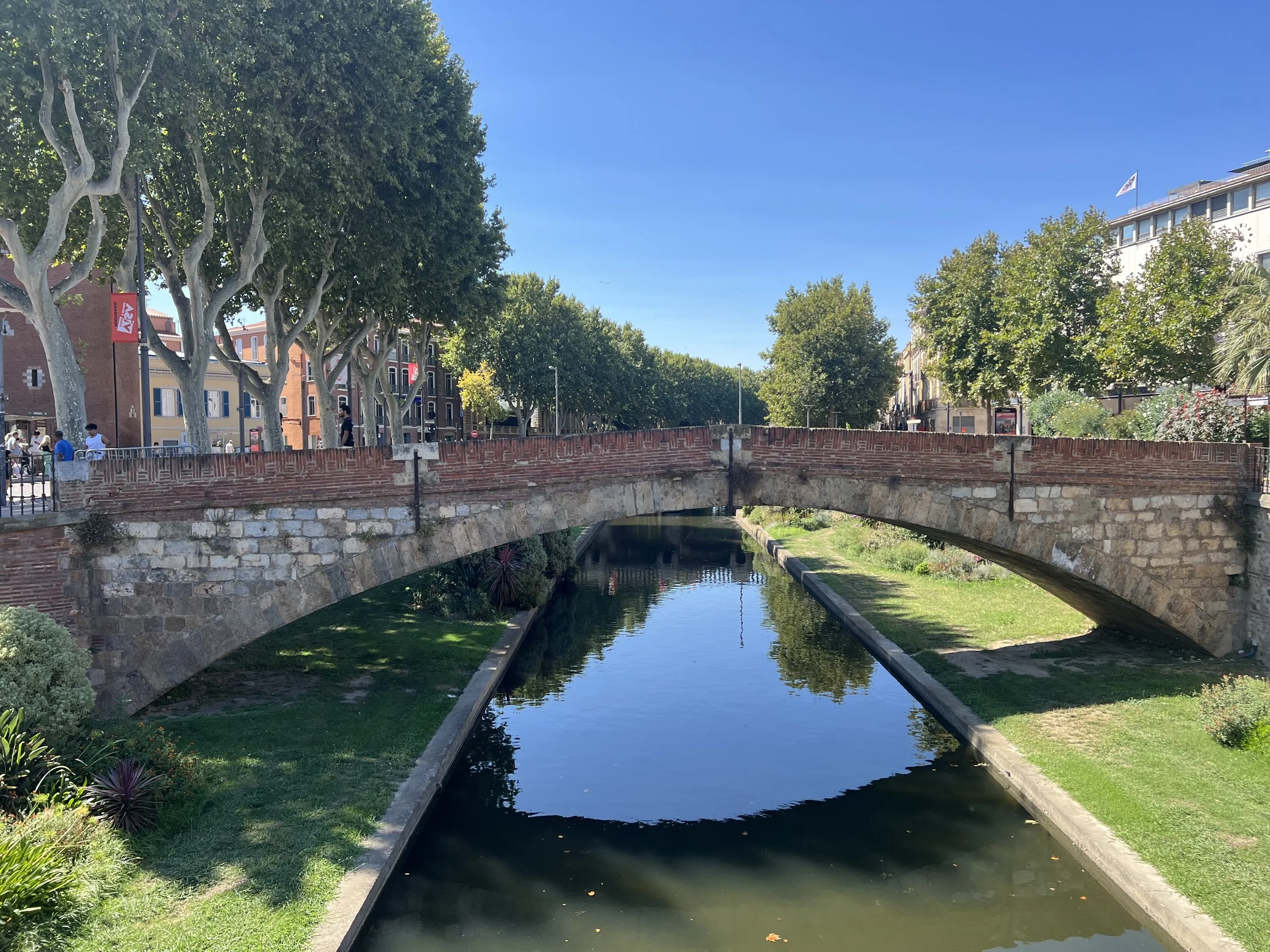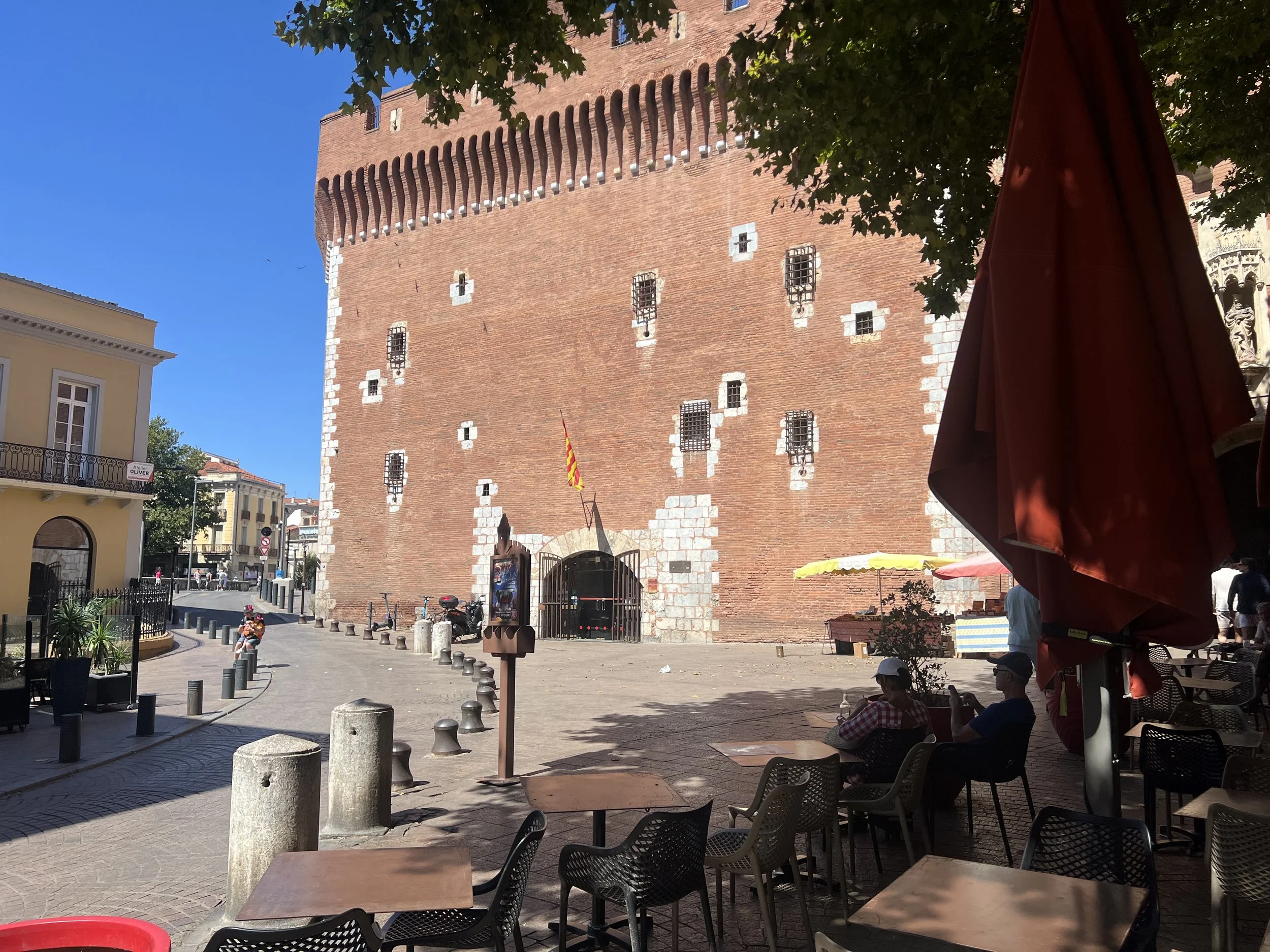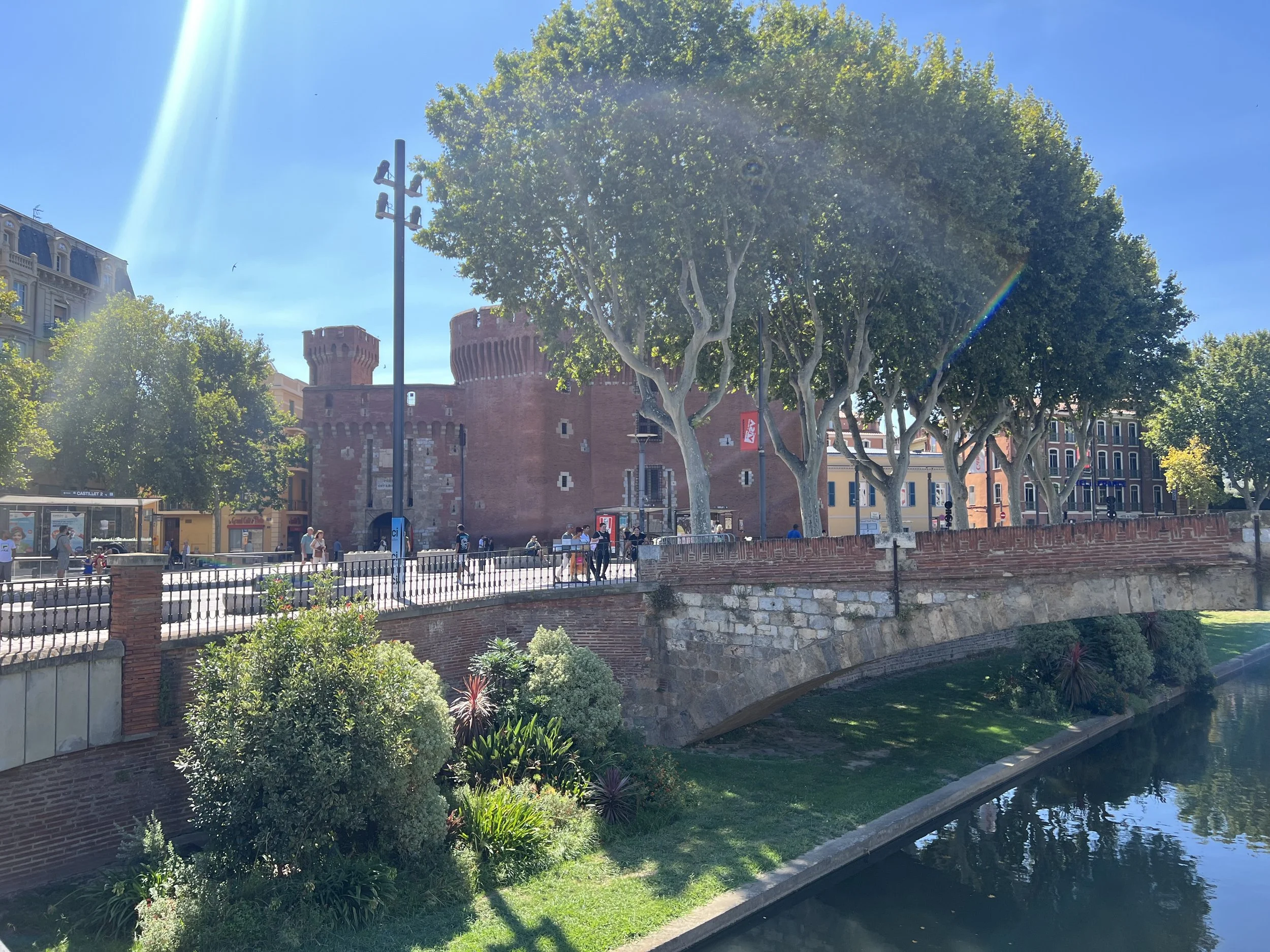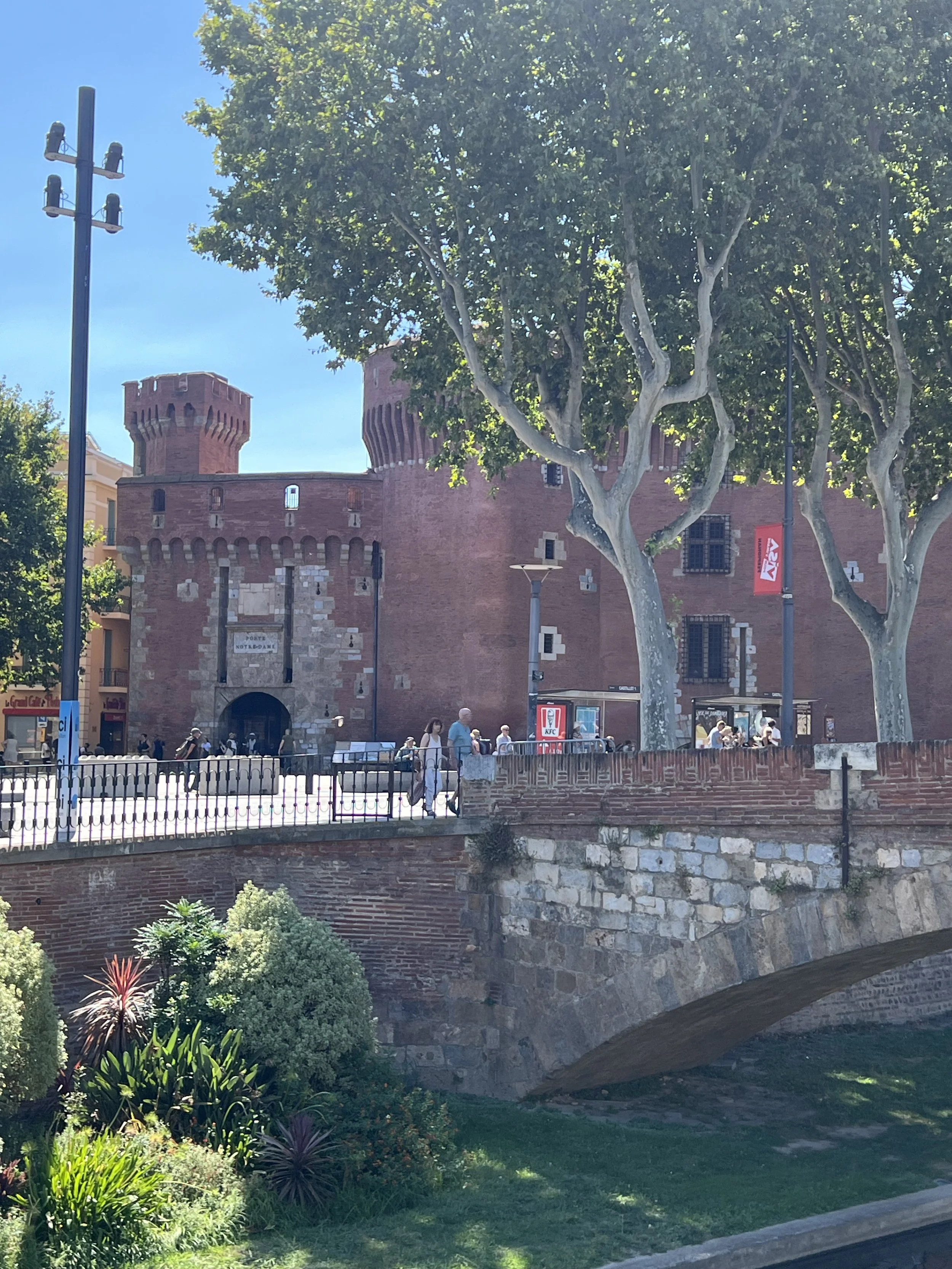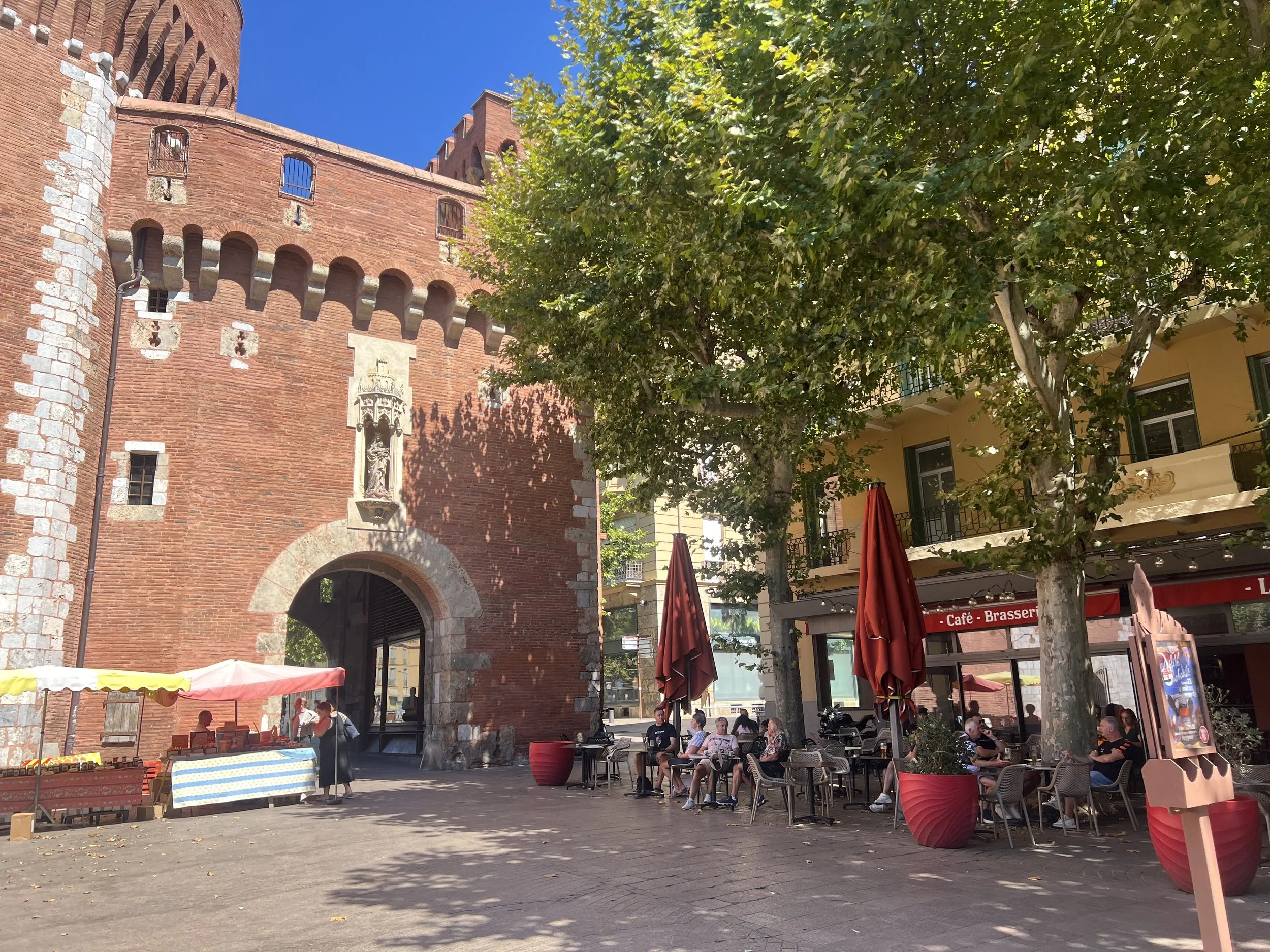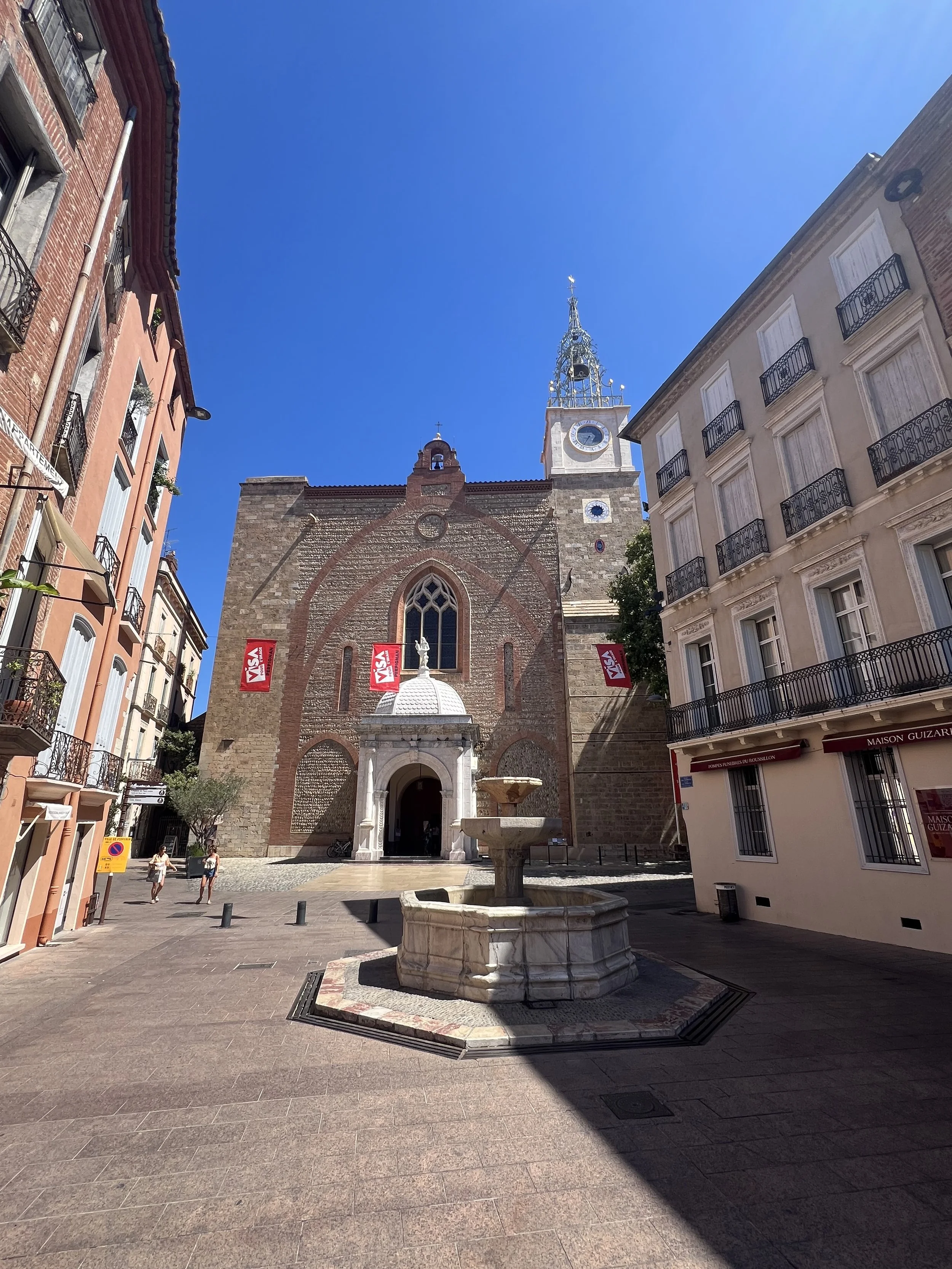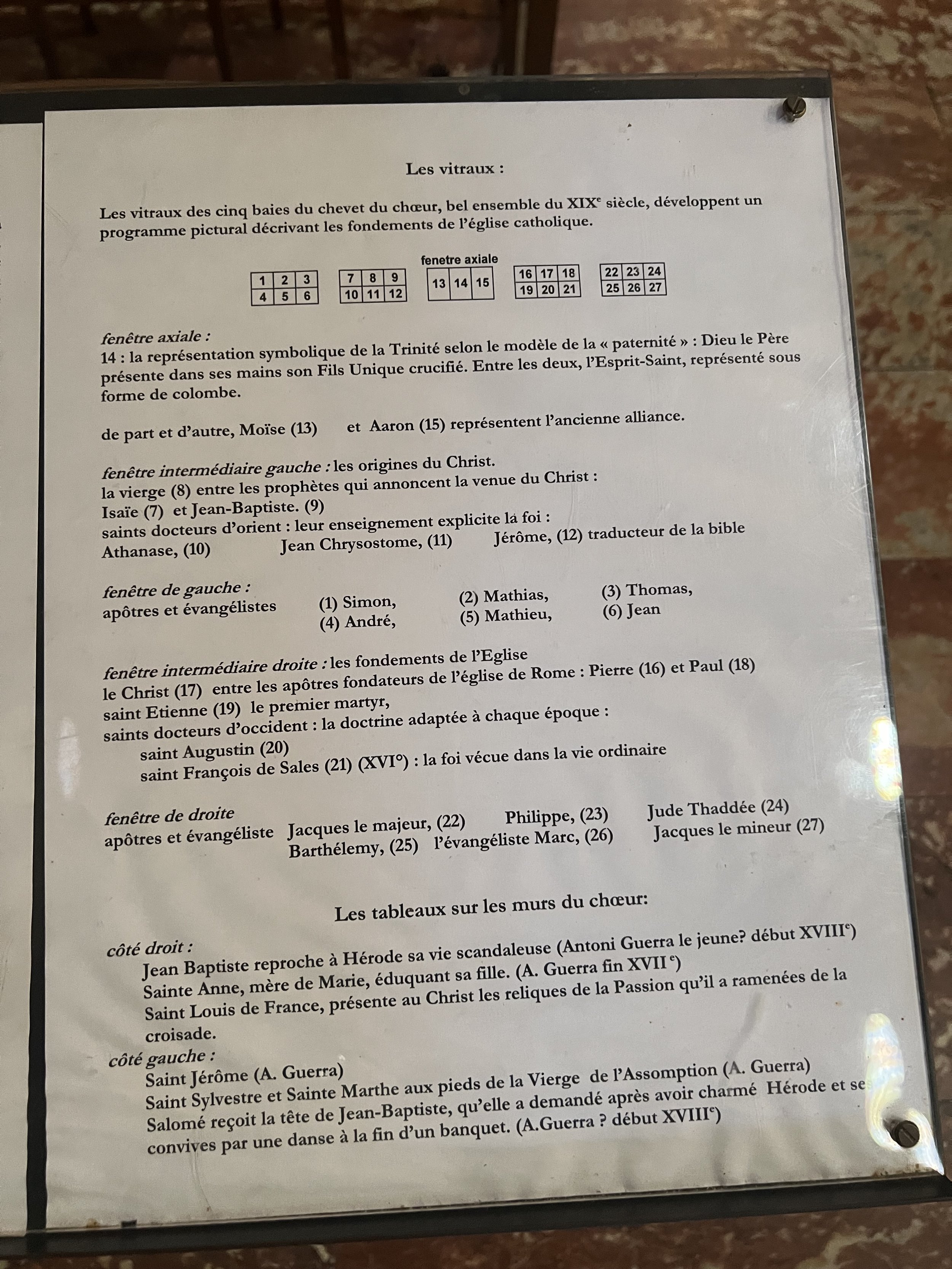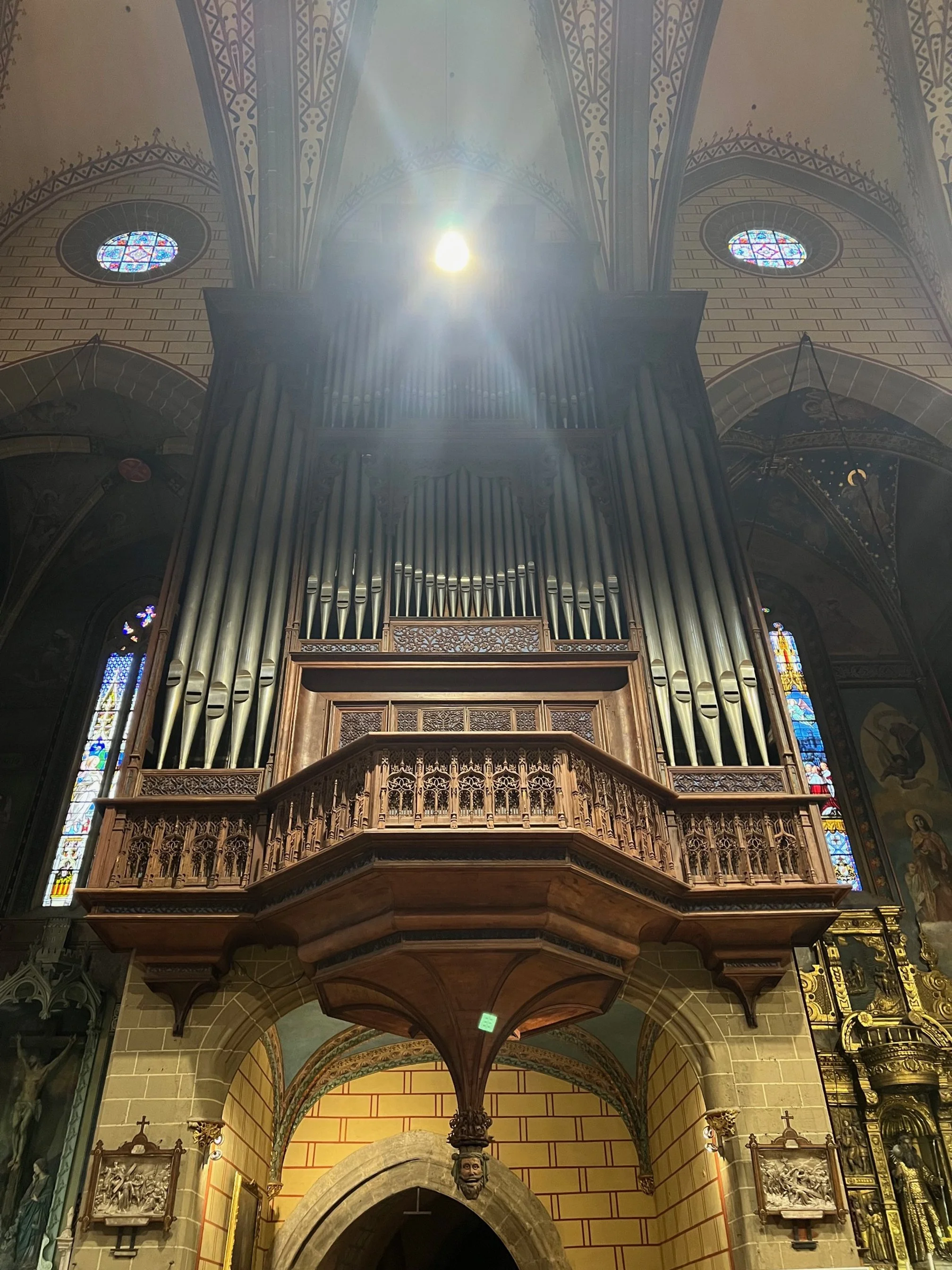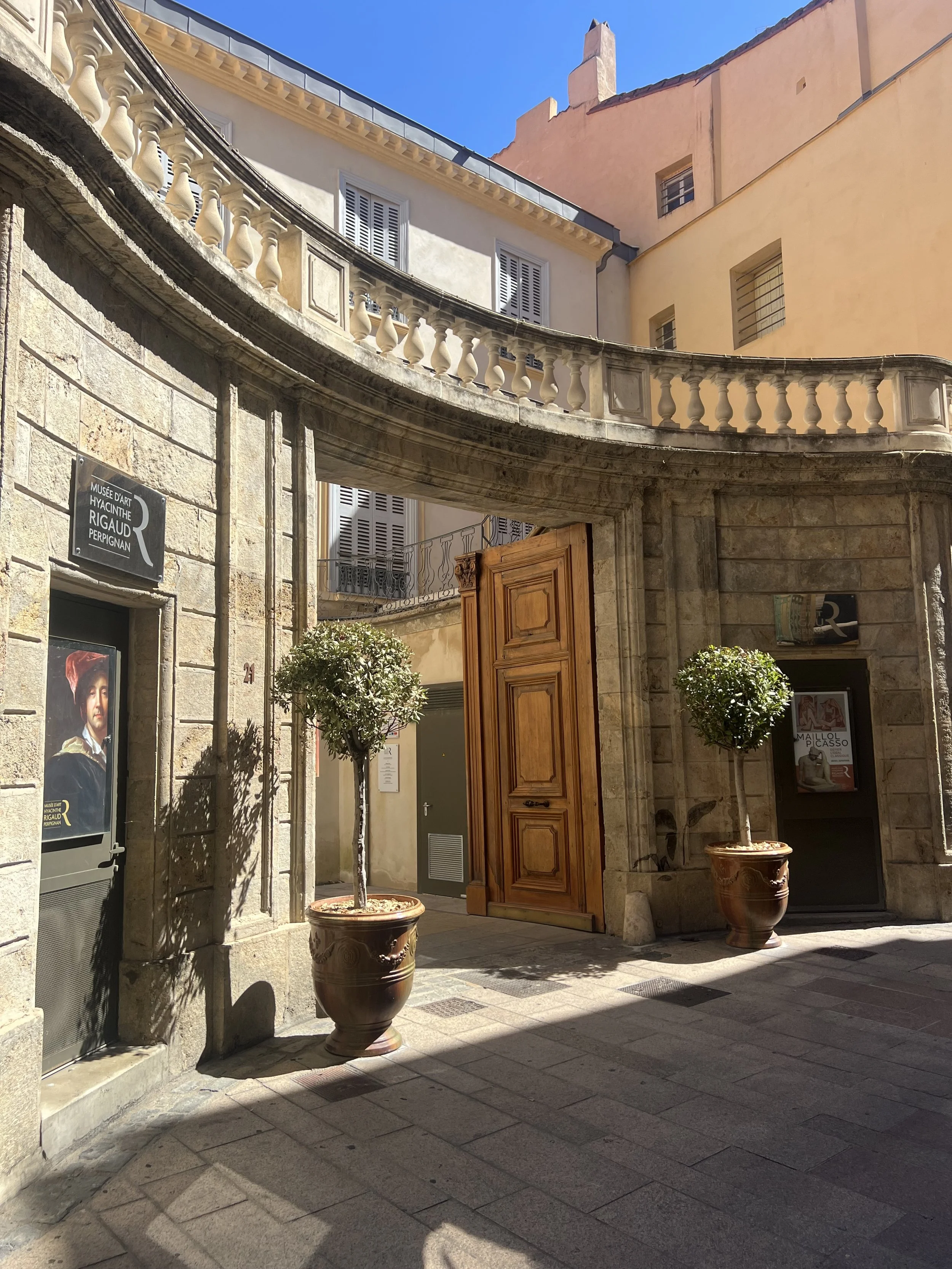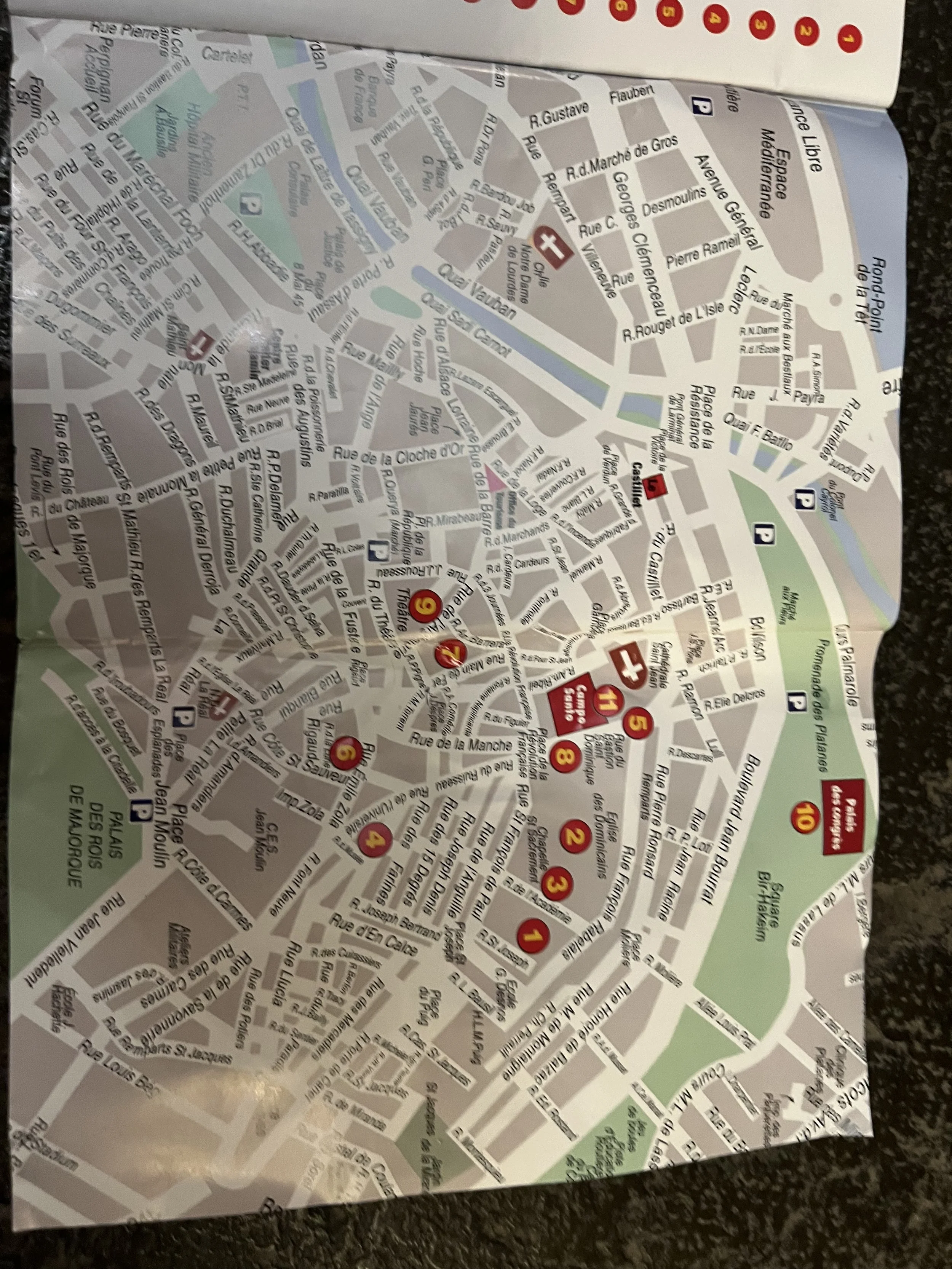
Tourist Attractions & Things To Do in Perpigan
-
Palais des Rois de Majorque (Palace of the Kings of Majorca)
Cathédrale Saint-Jean-Baptiste de Perpignan & Campo Santo
Casa Xanxo (Centre d’Interprétation de l’Architecture et du Patrimoine)
La Loge de Mer and Hôtel de Ville (Historic Centre & Place de la Loge)
Le Castillet
Place de Verdun, 66000 Perpignan, France
I often think if a building was to symbolise Perpignan, then Le Castillet would be it.
Le Castillet is the iconic red-brick gateway tower of Perpignan and the only remaining fragment of the medieval city walls. Back in the day, these city walls wrapped around the whole of the old town, but this is all that’s left.
It was built in 1368 and was always the main entrance into Perpignan. Over the centuries, Le Castillet was often a prison, particularly during the French Revolution, and you can see graffiti on the walls left by inmates. There is a little museum inside covering a little history of Roussilon from prehistoric settlers to locals crafts and folklore.
But, this is not the real reason to come and see it. It’s for the view…Climbing to the top of the Castillet is a must for panoramic views over the city’s rooftops, you can see the cathedral’s bell tower and the distant Pyrénées on a clear day. It’s also only 2 euros to get in – a bargain!
Normal opening hours for Le Castillet and Casa Pairal Museum are roughly October–May, Tuesday to Sunday from around 11:00–17:30, and extended hours in June–September (daily about 10:30–18:30). Closed on Mondays.
Palais des Rois de Majorque (Palace of the Kings of Majorca)
4 Rue des Archers, 66000 Perpignan, France
Probably the most famous and visited attraction is the Palace of the Kings of Majorca, a fortified royal palace crowning a hill just south of the old town. This vast citadel was begun in 1276 when King James II of Majorca made Perpignan the continental capital of his kingdom.
Completed in 1309, the palace was built in a Catalan Gothic style, with architects Pons Descoy and Ramon Pau designing an elegant residence within strong defensive walls. Over the next centuries, it hosted a summit of European leaders in 1415 during the Western Schism, withstood sieges (part of its northern wing was damaged in 1502), and after the region became French in 1659, the famed builder and architect, Vauban integrated it into a larger star-fort complex.
Today, visitors approach via zigzagging ramps and stairs, passing through multiple gatehouses until we reach the serene gardens, then into through the main gates and into the main courtyard to begin the tour of the Castle.
Once inside, it’s not terribly exciting. As with most French government run tourist sites, there’s almost nothing to see – often bare rooms with simple signs, such as the “King’s Chamber” and nothing more. If anyone from the Perpignan Tourist Office is reading this, please think more about making the place come alive. It has so much potential.
Here are some ideas to improve the experience:
Install audio speakers so you can hear different occasions, for example, feasts in the dining room, monks singing in the church, horses in the stable and bring back some atmosphere to the castle.
Add props to each room to show how they were used. For example, you could have a long table filled with medieval food so you can see what a feast would have been like. Or you could have a big bed for the King in the Kings Chamber. Let history come to life!
During tourist season, you could have young people acting as medieval knights, kings or monks wandering around and doing reenactments.
Provide more information in each room with a panel on the room with more detailed information on the room and how it was used (in English, French and Spanish).
In the gardens outside the castle, there is an opportunity for a lovely outdoor café with beautiful views of the whole city. It’s a huge missed opportunity!
In addition, I recommend climbing the Tour de l’Hommage (the keep) for a breathtaking 360° view over Perpignan’s rooftops, the Canigou mountain and the plains stretching toward the sea.
The palace is open to visitors year-round and operates daily with hours varying seasonally: in winter (Nov–Mar) roughly 10:00–17:00, extending to 18:00 in spring and autumn, and up to 18:30 during July–August. (Last entry is usually half an hour before closing.) Standard admission is about €7 for adults, with discounts for students and children (and occasionally free entry on first Sundays outside peak season).
Cathédrale Saint-Jean-Baptiste de Perpignan & Campo Santo
Place Gambetta, 66000 Perpignan, France
Perpignan’s Cathedral of Saint John the Baptist is really worth visiting. A masterpiece of southern Gothic architecture and the spiritual heart of the city, construction began in 1324 under King Sancho of Majorca, then stalled after the Kingdom of Majorca fell in 1349, and the cathedral wasn’t actually completed until the late 15th century.
Step inside the cathedral and you’ll be greeted by dim, cool air and the scent of candles. Uniquely, the finished design is Catalan Gothic with just a single 80 metre long nave that’s 26 metres high, which gives an impression of harmonious, cavernous space. The atmosphere is especially moving if you catch the choir singing or the bells tolling the hour from the iron belfry above.
A highlight is the Dévôt Christ (Dévot Crucifix), a revered 14th-century carved wooden crucifix, which is carried through the streets by hooded penitents during the famous La Sanch procession each Good Friday. But, I think the most interesting thing to see is the cathedral’s 16th century organ, which reaches down towards the Congregation. Atop the roof is a delicate wrought-iron bell tower (campanile) from 1743, whose openwork design is visible against the sky.
Entrance to the cathedral is free (donations welcomed), and it is generally open daily except during Mass services.
Right next to the Cathedral is the Campo Santo, built in the 13th century, which is one of France’s largest and oldest surviving medieval cemetery cloisters. It consists of an open rectangular courtyard surrounded by elegant arches. Originally, each arch bay contained tomb niches for notable families of Perpignan and you can still see carved coats of arms and Gothic tracery above the arches, which indicated the family vaults. At one end stands the Chapelle Notre-Dame-des-Anges (also called Chapelle de la Funéraria), a small chapel built in the 14th century, which is also worth seeing.
Musée d’Art Hyacinthe Rigaud
21 Rue Mailly, 66000 Perpignan, France
I really do think everyone who visits Perpignan should visit Musée d’Art Hyacinthe Rigaud. Whenever I’ve been, I’ve had the museum almost to myself and that’s a shame as I would argue it’s probably the best thing to see in Perpignan.
Named after the famed 18th-century portrait painter Hyacinthe Rigaud, who beckoned from Perpignan, it’s a wonderful museum travelling through time telling Perpignan’s story from medieval times to the bourgeois aristocracy before the Revolution and into Impressionist Perpignan and beyond.
Opened in 2017, the museum is housed in two elegant historic grand townhouses with marble staircases and painted ceilings, you’ll find medieval religious art all the way up to canvases by Picasso, Dalí, and Raoul Dufy.
The museum is usually open daily in summer (June–Sept around 10:30–19:00) and Tuesday–Sunday in the off-season (roughly 11:00–17:30 Oct–May). Like many French museums it closes on Mondays outside high season. Tickets cost €8 for adults, concessions are available (students and ages 12–18 around €6), and children under 12 are free. The museum also participates in the first Sunday of the month free entry scheme for the public, except in summer when major exhibitions are on.
Hôtel Pams
18 Rue Émile Zola, 66000 Perpignan, France
I have to adopt the much overused word “hidden gem” to Hôtel Pams and implore you to go – if it’s open – as sadly the opening hours are inconsistent (so, check before you travel, folks!).
Put simply, Hôtel Pams is a sumptuous Belle Époque mansion that offers a glimpse into the city’s opulent past. Despite the name, this isn’t a hotel at all, but the former private residence of the Bardou family, owners of the JOB cigarette paper empire, later inherited by their son-in-law Jules Pams, a politician and art patron.
The original building (on Rue Émile Zola in the old quarter) was constructed in the mid-19th century by Pierre Bardou, but, in the 1890s, Jules Pams transformed it into an Art Nouveau showpiece, enlisting architect Léopold Carlier and painter Paul Gervais to lavishly decorate the interiors. The result was a showcase of the wealth and taste of the bourgeoisie at the turn of the 20th century.
When you find the unassuming façade at number 18, you might be unsure if you’re in the right place – but if open, step through the doorway into a gorgeous inner courtyard adorned with a statue of Venus and lush plants.
A grand marble staircase leads up to the reception rooms. Visitors are typically allowed to wander through a few stunning salons on the piano nobile (first floor), which feature high ceilings, gilded moldings, and murals of romantic and mythological scenes by Gervais.
Look for details like onyx fireplaces, ornate wrought iron banisters, and mosaic floors that exemplify Art Nouveau and Neoclassical elegance. The music room and dining room retain period furnishings and artwork that transport you back to 1900. One famous painting by Gervais, “The Paradise of Women,” adorns a wall with its dreamy depiction of women in a garden – reflecting the indulgent spirit of the era.
My two wishes for Hôtel Pams is that it was open and publicised more and that more of the building was open as the top floor is closed off to the Public.
Casa Xanxo (Centre d’Interprétation de l’Architecture et du Patrimoine)
8 Rue de la Main de Fer, 66000 Perpignan, France
La Casa Xanxo is one of Perpignan’s most beautiful Gothic residences, but now an interactive heritage centre. Dating back to around 1508, this grand townhouse was built for a wealthy cloth merchant, Bernat Xanxo, and its splendid carved façade still bears a notable frieze depicting the Seven Deadly Sins in stone.
Stepping through the old wooden door on the narrow Rue de la Main de Fer, you enter a classic medieval Catalan patrician home: there’s a central courtyard with an external staircase and wooden gallery, leading to rooms with huge fireplaces.
Architectural details like ornate ribs in the ceilings, sculpted coats of arms, and mullioned windows have been preserved, showcasing 500 years of domestic decor and building techniques. It’s a rare chance to see how a well-to-do family in Perpignan lived in the early 16th century.
In recent years, Casa Xanxo has been transformed into the CIAP – Centre d’Interprétation de l’Architecture et du Patrimoine, essentially a local heritage museum and interpretation centre. Across its two floors, you’ll find exhibits about Perpignan’s history and architecture with interactive exhibits, videos and projections, scale models of the city, and multimedia from the Roman era through the medieval Kingdom of Majorca period up to the present. Admission is free. Casa Xanxo is typically open Tuesday to Sunday.
La Loge de Mer and Hôtel de Ville (Historic Centre & Place de la Loge)
Place de la Loge, 66000 Perpignan, France
As you wander the old quarter of Perpignan, you’ll inevitably end up in the Place de la Loge, a picturesque square that has been the civic heart of the city since medieval times.
The star attractions here are two historic buildings side by side: La Loge de Mer and the Hôtel de Ville (Town Hall).
La Loge de Mer, built in 1397, is a beautiful Gothic structure with an open loggia façade – its name literally means “Sea Lodge”.
In the XIV–XV centuries, this edifice served as Perpignan’s maritime commerce tribunal and stock exchange during medieval times. You can still admire the arched gallery and the intricate details on its stone columns and window tracery that reflect Catalan Gothic style. Look up at the top by the roof to see the ship symbol!
Today, the building is used as the Office de Tourisme, which I think is a shame as it’s such a beautiful building – it would be great to see it restored to its former glory. When I went in to the Office de Tourisme to ask them for more information on the history of the building for this guide, no one knew anything sadly.
Just next door, the Hôtel de Ville, is an eclectic mix from a fortified medieval entrance on one side to a grand Renaissance portal on the other. If the main doors are open during weekday hours, you can step into the inner courtyard of the Town Hall. There you’ll find a surprising art treasure: Aristide Maillol’s famous statue La Méditerranée serenely sitting in the centre of the courtyard.
On the corner opposite stands the Tour de l’Horloge (Clock Tower), originally a watchtower, which anchors one end of the square and adds to the old-world charm. Also adjacent is the Théâtre Municipal (Municipal Theatre), an Italian-style theatre from the 19th century with a pastel-painted facade adding a touch of Belle Époque flair to the square.
Natural History Museum (Muséum d’Histoire Naturelle)
Hôtel Çagarriga on Rue de la Fontaine Neuve, Perpignan
I would not call this a “must see”, but it’s an interesting curiosity and something kids will like. The Natural History Museum of Perpignan offers a captivating walkthrough of the region’s biodiversity and showcase local wildlife including wolves, bears and birds alongside geological samples and ethnological curiosities that together tell the story of this unique bioregion.
Perhaps the most striking oddity is an Egyptian mummy!
Opening hours vary seasonally: October to May, Tuesday to Sunday from around 11:00 to 17:30; June to September, longer days approximately 10:30 to 18:30. Closed on Mondays. Admission is free.
Couvent des Minimes
12 Rue Louis Bausil, 66000 Perpignan
An understated 17th-century former convent with vaulted ceilings and a peaceful courtyard, used today mainly for art and photography exhibitions. Even when not hosting Visa pour l’Image, it occasionally opens for temporary exhibitions or guided tours.

